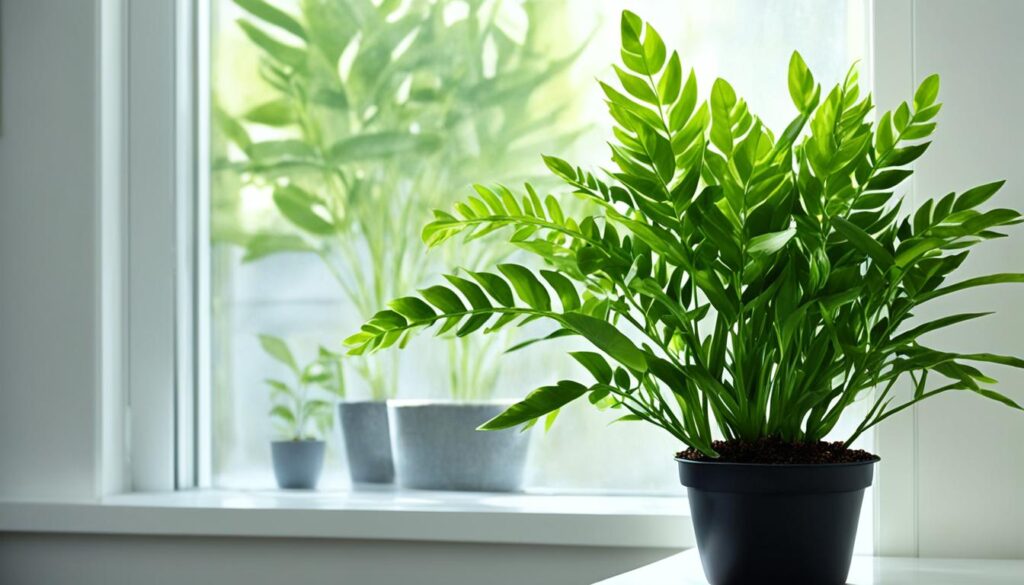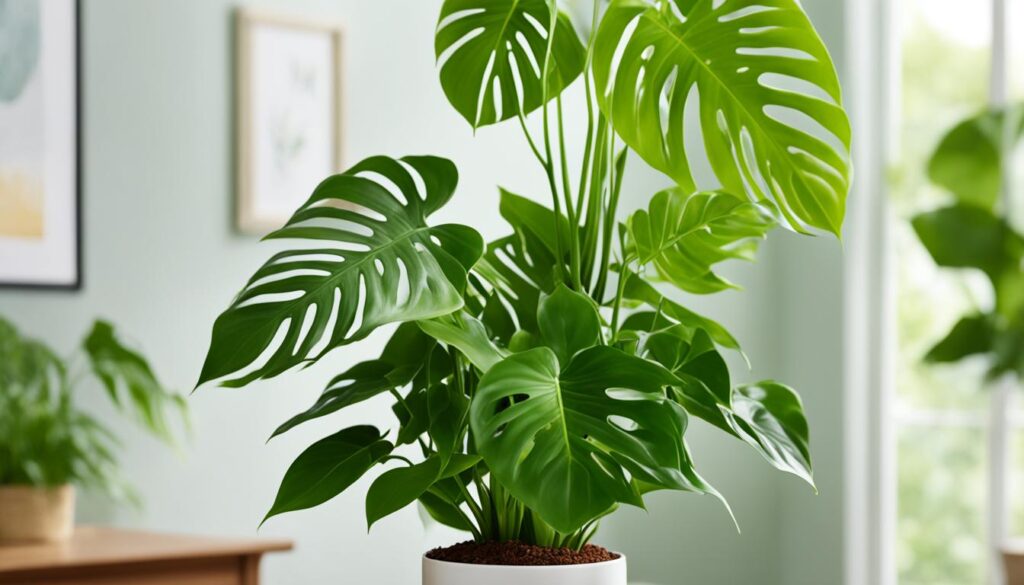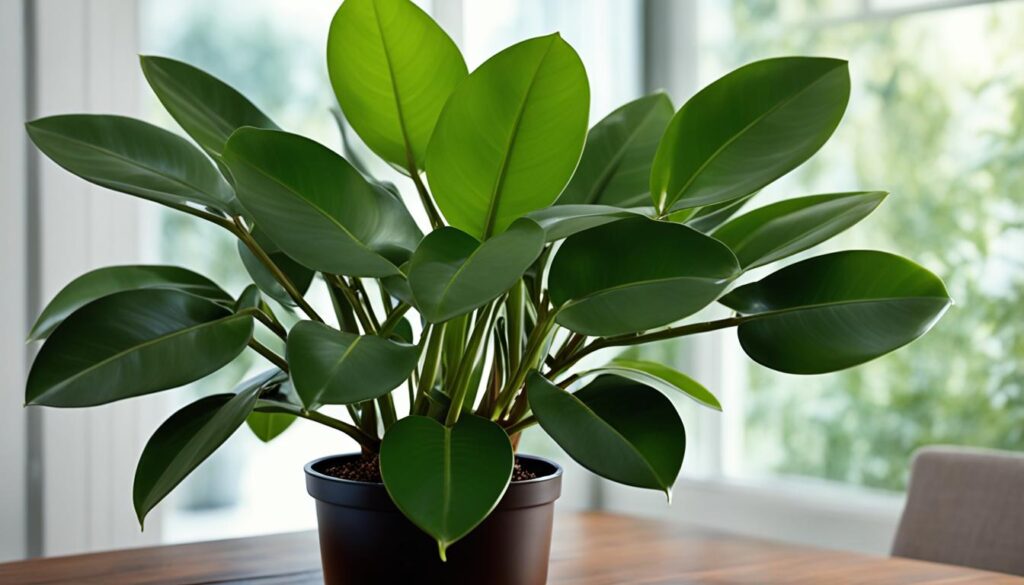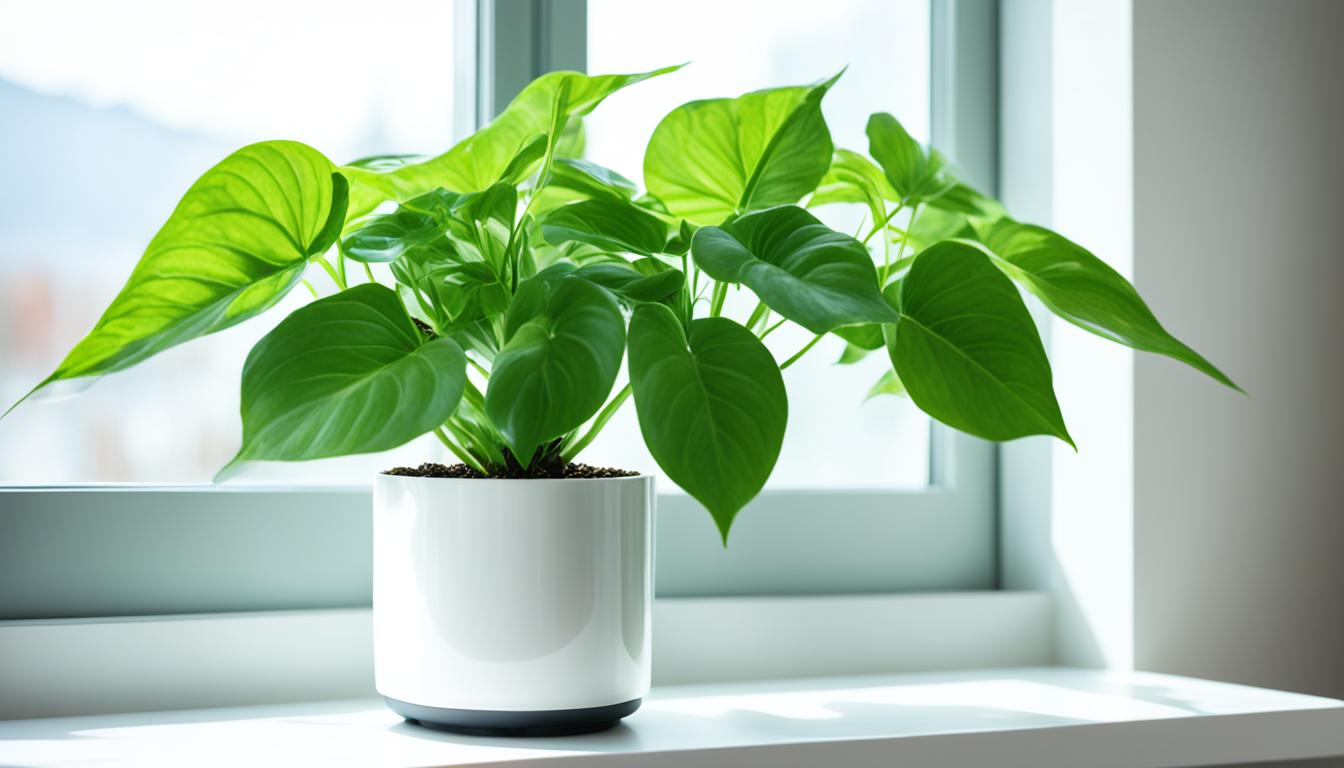Discover our top 10 easy-care houseplants that are perfect for beginners and beyond. Whether you’re a seasoned plant enthusiast or just starting your plant parenting journey, these low-maintenance indoor plants are sure to bring beauty and greenery into your space. From small apartments to low-light conditions, we’ve handpicked a selection of plants that will thrive in various environments.
Indoor plants not only enhance the aesthetic appeal of your home but also offer numerous health benefits. They can purify the air, improve concentration and productivity, and reduce stress levels. With the right plants, you can create a more inviting and relaxing atmosphere while effortlessly caring for them.
Join us as we explore the best indoor plants for beginners and their unique characteristics. Whether you have limited space, low-light conditions, or furry friends at home, we have a plant recommendation that suits your needs.
Key Takeaways:
- Choose from our top 10 easy-care houseplants perfect for beginners.
- Indoor plants can brighten your home and improve your well-being.
- Low-maintenance indoor plants are ideal for small spaces.
- Discover houseplants that thrive in low-light conditions.
- Find pet-friendly indoor plants that are safe for your furry friends.
Introduction
Welcome to the world of indoor plants! Whether you have a green thumb or are just starting your plant parenting journey, indoor plants are a fantastic way to bring nature into your home. Not only do they add beauty and tranquility to any space, but they also offer a wide range of benefits for your well-being. In this section, we will explore the world of indoor plants, discuss the basics of beginner plant care, and provide tips for choosing the right plants for your home.
“Bringing plants indoors has a calming effect, reduces stress, and boosts productivity.”
- Health Benefits: Indoor plants purify the air by removing toxins and increasing oxygen levels, improving indoor air quality and reducing the risk of respiratory problems.
- Aesthetics: Houseplants add color, texture, and life to any space, creating a visually pleasing and inviting atmosphere.
- Well-being: Studies show that being around plants can reduce stress levels, improve mood, and promote a sense of relaxation and well-being.
- Connection with Nature: Indoor plants provide a connection to the natural world, even in urban environments, helping to create a sense of harmony and peace.
Now that you understand the benefits, let’s explore some essential tips for beginner plant care:
- Choose plants that are suitable for indoor environments, such as low-light or low-maintenance varieties.
- Consider factors like light, temperature, and humidity when selecting plants to ensure they thrive in your home.
- Water your plants properly by understanding their specific watering needs and avoiding overwatering or underwatering.
- Provide adequate drainage for your plants to prevent waterlogged roots.
- Regularly check for pests and diseases to catch and treat issues early.
- Give your plants the right amount of space to grow and spread out.
By following these basic tips, even those with limited experience can become successful plant parents and enjoy the beauty and benefits of indoor plants.
Spider Plant (Chlorophytum comosum)
Best Indoor Plants for Beginners: Spider Plant Care Tips
The spider plant, also known as Chlorophytum comosum, is an excellent choice for beginners looking to add some greenery to their indoor space. This easy-care houseplant not only beautifies your home but also helps to purify the air. Here are some essential care tips to ensure the health and thriving of your spider plant:
Light Requirements
Spider plants prefer bright, indirect light but can tolerate lower light conditions. Place your spider plant near a window with filtered sunlight or at a spot away from direct sunlight to avoid leaf burn.
Watering Needs
Spider plants have moderate water requirements. Water your spider plant when the top inch of the soil feels dry to the touch. Be careful not to overwater, as it can lead to root rot. Spider plants also appreciate slightly higher humidity levels.
Propagation Methods
Spider plants are known for their ability to produce “spiderettes” or baby plants that hang from the mother plant. These spiderettes can be rooted in water or potted in well-draining soil to grow into new plants. Propagation through division is another method where you can separate the plant’s root clumps into individual plants.
Overall, spider plants are low-maintenance and adaptable, making them an ideal choice for beginner plant parents. Enjoy the vibrant green foliage and air-purifying benefits that the spider plant brings to your home.
Snake Plant (Sansevieria)
The snake plant, or Sansevieria, is a popular choice among beginners due to its low-maintenance nature and hardiness. This plant is incredibly easy to care for, making it an ideal option for those new to plant parenting. With its upright, sword-like leaves and ability to purify the air, the snake plant is both visually appealing and beneficial for your indoor environment.
How to Care for Snake Plants: A Beginner’s Guide
Snake plants are known for their ability to thrive in various indoor conditions and require minimal care. Here are some essential tips to help you care for your snake plant:
- Light Requirements:
- Snake plants can tolerate a wide range of lighting conditions, from low light to bright indirect light.
- Place your snake plant near a window where it can receive filtered sunlight.
- Watering:
- Snake plants are drought-tolerant and should be watered sparingly.
- Allow the soil to dry out completely between waterings.
- Avoid overwatering, as it can lead to root rot.
- Propagation:
- Snake plants are easy to propagate through division or leaf cuttings.
- To divide your snake plant, carefully separate the rhizomes and repot them in separate containers.
- To propagate using leaf cuttings, select a healthy leaf, cut it into several sections, and plant them in a well-draining potting mix.
- Common Issues:
- Overwatering is the most common issue with snake plants. Ensure the soil has dried out before watering again.
- If the leaves start turning yellow, it may be a sign of overwatering or inadequate light.
- Spider mites can occasionally infest snake plants. Use a neem oil solution or wipe the leaves with a damp cloth to remove the pests.
With proper care, your snake plant will thrive and bring a touch of green into your home. This low-maintenance plant is an excellent choice for beginners looking to enhance their indoor space with a resilient and beautiful houseplant.
Pothos (Epipremnum aureum)
Beginner’s Guide to Pothos Care: Tips and Tricks
Pothos, also known as Epipremnum aureum, is a versatile and easy-to-care-for houseplant that is perfect for beginners. With its trailing vines and heart-shaped leaves, pothos is a popular choice for adding greenery to small spaces.
In this section, we will provide a comprehensive guide on pothos care, including:
- Light and water requirements
- Pruning techniques
- Propagation methods
Whether you have limited space or are new to plant care, pothos is an ideal low-maintenance indoor plant that will thrive in various environments. Let’s explore the best practices for caring for your pothos plant to ensure it remains happy and healthy in your home.
Peace Lily (Spathiphyllum)
The Ultimate Peace Lily Care Guide for Beginners
The peace lily, scientifically known as Spathiphyllum, is a beautiful and low-maintenance plant that thrives in low-light conditions. In this section, we will provide a comprehensive care guide for peace lilies, including light and water requirements, potting tips, and common issues to watch out for. Peace lilies are not only aesthetically pleasing but also known for their air-purifying qualities, making them a popular choice for any beginner plant parent.
| Light Requirements | Watering Needs | Potting Tips | Common Issues |
|---|---|---|---|
| Peace lilies thrive in low-light environments, making them ideal for areas with limited natural light. | These plants prefer slightly moist soil but can tolerate periods of drought. Water them when the top inch of soil feels dry. | Use a well-draining potting mix and choose a container with drainage holes to prevent waterlogged roots. | Yellow leaves may indicate overwatering, while brown tips can be a sign of underwatering. Peace lilies are also sensitive to cold drafts and may develop brown spots if exposed. |
ZZ Plant (Zamioculcas zamiifolia)
The ZZ plant, or Zamioculcas zamiifolia, is a hardy and low-maintenance houseplant that is perfect for beginners. With its glossy dark green leaves and ability to thrive in low-light environments, the ZZ plant is a great addition to any beginner’s plant collection.
ZZ Plant Care Tips for Beginners: Everything You Need to Know
When it comes to caring for ZZ plants, there are a few key factors to consider.
- Light: ZZ plants are known for their ability to tolerate low-light conditions, making them perfect for those shady corners in your home. Place your ZZ plant in a spot where it can receive indirect, bright light for a few hours each day.
- Water: ZZ plants have a unique water storage system, making them drought-tolerant and low-maintenance. Allow the top inch of soil to dry out before watering your ZZ plant. Overwatering can lead to root rot, so it’s best to err on the side of underwatering.
- Potting: ZZ plants prefer to be slightly root-bound, so choose a pot that is just a bit larger than the plant’s root ball. Use a well-draining potting mix to prevent waterlogging.
- Temperature: ZZ plants thrive in average room temperatures between 65-75°F (18-24°C). Avoid exposing your ZZ plant to extreme temperature fluctuations or cold drafts.
- Fertilizer: ZZ plants are low-maintenance when it comes to fertilizing. Feed your plant with a balanced liquid fertilizer once a month during the spring and summer growing seasons.
Despite their resilient nature, ZZ plants can still face a few common issues, such as yellowing leaves or pests. If you notice any signs of trouble, such as yellow leaves, adjust the watering or light conditions accordingly. If pests like mealybugs or spider mites appear, wipe them off with a damp cloth or use an insecticidal soap.
The ZZ plant’s low-light and low-maintenance requirements make it an excellent choice for beginners. With a little care and attention, you can enjoy the beauty of this sturdy and versatile houseplant in your home.

Philodendron
Philodendrons are a diverse group of indoor plants that are perfect for beginners. With their easy-care requirements and ability to thrive in various lighting conditions, philodendrons are an excellent choice for any beginner plant parent.
If you’re new to caring for indoor plants, here is a beginner’s guide to philodendron care:
Light and Water Requirements
Philodendrons are adaptable when it comes to lighting conditions, but they prefer bright, indirect light. Place your philodendron near a window where it can receive filtered sunlight. Avoid direct sunlight, as it can scorch the leaves.
As for watering, philodendrons like to stay evenly moist but not waterlogged. Water your philodendron when the top inch of soil feels dry to the touch. Make sure to provide adequate drainage to prevent overwatering.
Propagation Methods
Philodendrons can be propagated through stem cuttings. Select a healthy stem, preferably with a few nodes, and make a clean cut just below a node. Place the cutting in a well-draining potting mix and keep it slightly moist until roots develop.
Another method of propagation is by dividing the plant. Gently separate the rootball into smaller sections, making sure that each section has roots and leaves. Plant the divisions in individual pots, and water them thoroughly.
Common Varieties
There are numerous philodendron varieties to choose from, each with its own unique foliage. Some popular varieties for beginners include:
- Philodendron Brasil: This variety has heart-shaped leaves with yellow variegation.
- Philodendron Micans: Known for its velvety, dark green leaves with bronze undertones.
- Philodendron Selloum: This variety features large, deeply lobed leaves that resemble an umbrella.
- Philodendron Heartleaf: With its heart-shaped leaves, this variety is a classic choice for any indoor plant collection.
Philodendron
Philodendron Care Tips: A Beginner’s Guide
Philodendrons are a diverse group of indoor plants that are perfect for beginners due to their easy care requirements and ability to thrive in various lighting conditions.
In this section, we will provide a beginner’s guide to philodendron care, including light and water requirements, propagation methods, and common varieties to consider.
One important aspect of caring for philodendrons is providing the right amount of light. Most philodendron varieties prefer bright, indirect light, but can tolerate lower light levels as well. Keep your philodendron in a well-lit area away from direct sunlight to avoid leaf burn.
When it comes to watering, philodendrons like to be kept evenly moist but not waterlogged. Allow the top inch of soil to dry out before watering again. Overwatering can lead to root rot, so it’s essential to find a balance.
Propagation is relatively easy with philodendrons. One common method is by stem cuttings. Simply cut a healthy stem just below a node and place it in water or a well-draining potting mix. Roots will typically develop within a few weeks, and you can then transfer the cutting to a new pot.
There are many varieties of philodendrons to choose from, each with its own unique characteristics. Some popular trailing varieties include the Heartleaf Philodendron (Philodendron hederaceum) and the Micans Philodendron (Philodendron micans), known for their lush foliage and long vines that gracefully cascade down from hanging pots.
By following these care tips, you can enjoy the beauty of philodendrons and their trailing vines in your indoor space. These easy-care houseplants are a great choice for any beginner plant parent looking to add some greenery to their home.

Aloe Vera
Aloe Vera Care Guide for Beginners: Tips for Success
Aloe vera is a popular succulent plant known for its healing properties and low maintenance needs, making it an excellent choice for beginners. Whether you’re new to plant care or looking for a low-maintenance indoor plant, aloe vera is a great option to consider. In this section, we will provide a comprehensive care guide to help you successfully care for your aloe vera plant.
Light Requirements
Aloe vera plants thrive in bright, indirect light but can also tolerate partial shade. Place your plant near a sunny window where it can receive at least six hours of indirect sunlight each day.
Watering and Soil
Aloe vera plants have succulent leaves that store water, so it’s important not to overwater them. Allow the soil to dry out completely between waterings and then thoroughly water the plant until water drains from the bottom of the pot. Use a well-draining soil mix specifically formulated for succulents to prevent root rot.
Fertilizing
Aloe vera plants are not heavy feeders. Fertilize your plant once or twice a year during the growing season with a balanced liquid fertilizer diluted to half strength.
Propagation
Aloe vera can be easily propagated by removing offsets, also known as pups, that grow around the base of the mother plant. Gently separate the pups and plant them in their own pots with well-draining soil. Allow the cut ends to dry out for a few days before planting to prevent rot.
Common Uses
Aloe vera gel has a variety of uses and is commonly used to soothe sunburns, cuts, and skin irritations. Simply cut a leaf from your aloe vera plant and squeeze out the gel to apply directly to the affected area. It can also be used as a natural moisturizer for the skin.
With its healing properties, low maintenance needs, and versatile uses, aloe vera is a must-have plant for any beginner plant enthusiast. Follow these care tips and enjoy the benefits of owning this beautiful succulent!
Rubber Plant (Ficus elastica)
The rubber plant, scientifically known as Ficus elastica, is a popular choice for beginners due to its low maintenance requirements and air-purifying qualities. With its thick, glossy leaves and ability to adapt to various indoor environments, the rubber plant is a great addition to any beginner’s plant collection.
When it comes to caring for your rubber plant, there are a few key things to keep in mind. Here are some tips and tricks to ensure your rubber plant thrives:
Light Requirements
The rubber plant prefers bright, indirect light. Place it near a window where it can receive plenty of natural light, but avoid direct sunlight as it can scorch the leaves. If you notice your plant leaning towards the light, rotate it every few weeks to ensure even growth.
Watering
Water your rubber plant thoroughly when the top inch of soil feels dry to the touch. Be careful not to overwater, as this plant is susceptible to root rot. Allow the excess water to drain out of the pot, and avoid leaving the plant sitting in water.
Pruning
Pruning your rubber plant is important for maintaining its shape and preventing it from becoming too leggy. Remove any dead or yellowing leaves, as well as any branches that are growing in an unwanted direction. You can also pinch back the tips of the plant to encourage bushier growth.
Common Issues
While the rubber plant is relatively low-maintenance, it can still face a few common issues. Overwatering can lead to root rot, so make sure to let the soil dry out between waterings. Browning or yellowing leaves usually indicate underwatering, while black spots might be a sign of overwatering or a fungal infection. If you notice any of these issues, adjust your watering routine accordingly and consider using a fungicide if necessary.

With these tips and tricks, you’ll be well on your way to successfully caring for your rubber plant. Enjoy the beauty and air-purifying benefits of this wonderful houseplant!
Boston Fern (Nephrolepis exaltata)
Boston ferns, scientifically known as Nephrolepis exaltata, are popular indoor ferns that are perfect for beginners due to their low light tolerance and easy care requirements. These lush and feathery ferns can add a touch of elegance to any indoor space.
How to Care for Boston Ferns: A Beginner’s Guide
When it comes to caring for Boston ferns, there are a few key factors to keep in mind:
- Light: Boston ferns thrive in bright, indirect light. Place them near a north or east-facing window to provide them with the right amount of light. Avoid direct sunlight, as it can scorch the delicate fronds.
- Water: These ferns prefer consistently moist soil, but not waterlogged. Check the top inch of soil regularly and water when it feels dry. Mist the fronds regularly to maintain humidity levels.
- Humidity: Boston ferns thrive in humid environments. Consider placing a humidifier near your plant or keeping it in a bathroom or kitchen where humidity levels are naturally higher. Alternatively, you can create a humidity tray by placing the pot on a tray filled with water and pebbles.
- Temperature: These ferns prefer temperatures between 60-75°F (15-24°C). Avoid placing them near drafty windows or in areas with fluctuating temperatures.
- Fertilizer: Feed your Boston fern with a balanced liquid fertilizer every 2-4 weeks during the growing season (spring and summer). Follow the package instructions for proper dilution.
It’s important to note that Boston ferns can be sensitive to changes in their environment. If you notice any browning or wilting fronds, adjust the care accordingly. With the right conditions and care, your Boston fern will thrive and bring a touch of natural beauty to your indoor space.
Chinese Evergreen (Aglaonema)
Chinese Evergreen Care Guide for Beginners: Tips and Tricks
Chinese evergreen plants, scientifically known as Aglaonema, are popular low-light indoor plants that are perfect for beginners. With their vibrant and colorful foliage, Chinese evergreens are not only aesthetically pleasing but also easy to care for. In this section, we will provide a comprehensive care guide for Chinese evergreen plants, including light and water requirements, potting tips, and common varieties to consider.
Light Requirements: Chinese evergreens thrive in low to medium indirect light conditions, making them ideal for areas of your home with limited natural light. Avoid direct sunlight, as it can scorch the leaves and cause damage.
Watering: Chinese evergreens prefer slightly moist soil, but they are sensitive to overwatering. Allow the top inch of soil to dry out between waterings, and ensure that the pot has drainage holes to prevent waterlogging. It’s always better to underwater than to overwater these plants.
Potting: Use well-draining soil and a pot with drainage holes to ensure proper water management. Chinese evergreens prefer slightly crowded roots, so there’s no need to repot them frequently. Repotting every two to three years should be sufficient.
Common Varieties: Chinese evergreens are available in various cultivars with different leaf patterns and colors. Some popular ones include:
| Variety | Leaf Pattern | Color |
|---|---|---|
| Aglaonema ‘Silver Queen’ | Variegated | Silver and green |
| Aglaonema ‘Red Ruby’ | Variegated | Green and red |
| Aglaonema ‘Emerald Beauty’ | Solid | Green |
These are just a few examples of the stunning varieties of Chinese evergreens available to choose from.
With their ability to thrive in low-light environments and their low-maintenance nature, Chinese evergreens are an excellent choice for any beginner plant parent. Whether you’re looking to add a pop of color to your home or seeking an easy-care plant for your office, Chinese evergreens are sure to bring beauty and tranquility to any space.
Conclusion
Indoor plants are a fantastic addition to any home, providing numerous benefits for both your physical and mental well-being. Throughout this article, we have explored a variety of easy-care houseplants that are perfect for beginners like you. By incorporating these plants into your living space, you can create a soothing environment, improve indoor air quality, and enhance your overall quality of life.
As you embark on your plant parenting journey, remember the key points we’ve discussed. Choose plants that suit your lifestyle and living conditions, such as low-maintenance varieties that can thrive in various light levels. Take the time to understand each plant’s specific care requirements, including their preferred watering schedules, sunlight exposure, and potential propagation methods.
With the right knowledge and a little bit of love, you can successfully nurture and care for indoor plants as a beginner. Remember to be patient with yourself and your plants, as it may take time to develop your green thumb. There are numerous resources available online, from plant care blogs to gardening communities, where you can find additional information and support.
So, why wait? Step into the world of indoor plant parenting and experience the joy and beauty these plants can bring to your home. Explore the recommended easy-care houseplants from this article and let nature’s vibrant greens become an integral part of your life. Start your plant collection today and enjoy the many benefits that indoor plants offer while immersing yourself in the fulfilling journey of plant care and growth.
For more valuable Expert Tips check out our comprehensive Houseplant Guide to Tips for Indoor Plant Care.
If you happen to be nearby, stop in at The Landscape Connection and say Hi. Michelle and I would love to meet you.
FAQ
Why should I consider adding indoor plants to my home?
Indoor plants offer several benefits, including improved air quality, added visual appeal, and a sense of tranquility. They can also help reduce stress and increase productivity.
What are the best indoor plants for beginners?
Some of the best indoor plants for beginners include spider plants, snake plants, pothos, peace lilies, ZZ plants, philodendrons, aloe vera, rubber plants, Boston ferns, and Chinese evergreen plants.
What are the key factors to consider when choosing indoor plants for beginners?
When choosing indoor plants for beginners, consider factors such as the amount of light available in your space, the level of maintenance the plant requires, and any specific needs you have, such as pet-friendliness or air-purifying properties.
How often should I water my indoor plants?
The water frequency will vary depending on the specific plant. As a general guideline, it is best to allow the top inch of soil to dry out between waterings. Avoid overwatering, as it can lead to root rot.
Can I place indoor plants in low-light areas?
Yes, there are several indoor plants that can thrive in low-light conditions. Some examples include snake plants, ZZ plants, and Chinese evergreen plants. However, it is important to note that even low-light plants still need some natural or artificial light to survive.
Are there any indoor plants that are safe for pets?
Yes, there are several pet-friendly indoor plants, such as spider plants, Boston ferns, and some varieties of philodendrons. However, it’s always best to research specific plants and ensure they are non-toxic to pets before bringing them into your home.
How can I propagate my indoor plants?
Propagation methods vary depending on the plant species, but some common methods include stem or leaf cuttings, division, and air layering. Research the specific plant you want to propagate for detailed instructions.
What are the air-purifying benefits of indoor plants?
Many indoor plants help improve air quality by removing toxins and releasing oxygen. Some examples of air-purifying plants include snake plants, peace lilies, and Chinese evergreen plants.
How can I ensure the health of my indoor plants?
To ensure the health of your indoor plants, it’s important to provide them with the right amount of light, water, and humidity. Additionally, be sure to monitor for any signs of pests or diseases and address them promptly.
Can I keep indoor plants in small spaces?
Yes, there are many indoor plants that are suitable for small spaces. Consider plants with compact growth habits, such as pothos or snake plants, or utilize hanging or wall-mounted planters to maximize space.
Where can I find more resources on indoor plant care?
There are several online resources, plant care websites, and plant care books that can provide detailed information on caring for indoor plants. Additionally, local nurseries or plant shops may offer workshops or classes on plant care.





Pingback: The Ultimate Guide to Indoor Plant Care: 20 Essential Tips – Trusted House Plant Guide